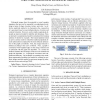Free Online Productivity Tools
i2Speak
i2Symbol
i2OCR
iTex2Img
iWeb2Print
iWeb2Shot
i2Type
iPdf2Split
iPdf2Merge
i2Bopomofo
i2Arabic
i2Style
i2Image
i2PDF
iLatex2Rtf
Sci2ools
129
Voted
ISBI
2009
IEEE
2009
IEEE
Structural Annotation of EM Images by Graph Cut
Biological images have the potential to reveal complex signatures that may not be amenable to morphological modeling in terms of shape, location, texture, and color. An effective analytical method is to characterize the composition of a specimen based on user-defined patterns of texture and contrast formation. However, such a simple requirement demands an improved model for stability and robustness. Here, an interactive computational model is introduced for learning patterns of interest by example. The learned patterns bound an active contour model in which the traditional gradient descent optimization is replaced by the more efficient optimization of the graph cut methods. First, the energy function is defined according to the curve evolution. Next, a graph is constructed with weighted edges on the energy function and is optimized with the graph cut algorithm. As a result, the method combines the advantages of the level set method and graph cut algorithm, i.e., “topological” i...
Related Content
| Added | 19 May 2010 |
| Updated | 19 May 2010 |
| Type | Conference |
| Year | 2009 |
| Where | ISBI |
| Authors | Hang Chang, Manfred Auer, Bahram Parvin |
Comments (0)

